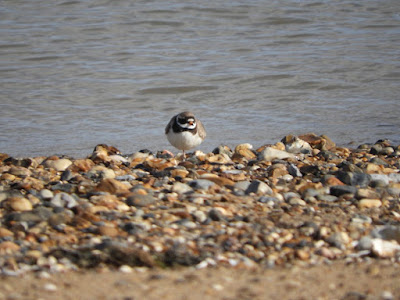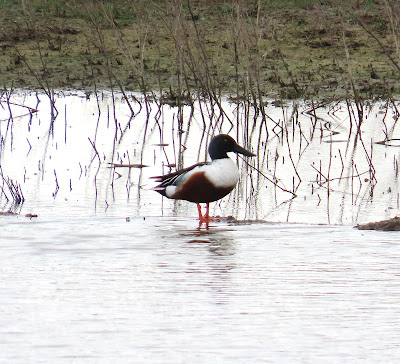Two willow warblers were singing in the park, also two lesser whitethroats and two whitethroats heard in the park with a few chiffchaffs and blackcaps. Four sand martins were flying over the park, three swallows to the north of the park also another lesser whitethroat here.
A buzzard circled over the pond, kestrel perched on the tree and a sparrowhawk flew east over the river. On the pond were the pair of nesting mute swans and two pochard while on the grazing fields and dyke were a pair of lapwing, pair of greylag geese, two shoveler, 20 teal, gadwall and eight tufted ducks.
Also on Wednesday a pair of avocets were on the Golfhouse pools, 6 shelduck, twenty brent geese, eight curlew and six redshank, while two great crested grebes in the river Colne. There was the scarce sighting of a harbour porpoise seen just off the Point swimming back and forth in the river, surfacing regularly but only for a split second each time.
The pair of kestrels was perched on their tree with the nestbox at the park on Tuesday, photo by Caroline. Also three chiffchaffs, four blackcaps, pair of mute swans on the pond, Cetti's warbler and blackcap at the pond but no sign of the barn owl in the early evening.
Michael Thorley photographed this Ichneumon stramentor wasp in his conservatory at his East Mersea house on Tuesday.
A pair of greylag geese stopped off in one of the fields by the Strood channel to feed before flying off, on Monday 15th. Ten avocets and two black-tailed godwits were the only birds of note along the Strood.
A male linnet was singing by the Strood dyke, the branches swaying in the fresh breeze. Four corn buntings flew over and landed in the field to feed.
Two adders were seen basking in the morning sunshine at the park.
Andy Field also visited East Mersea Point on Wednesday and saw seven black-tailed godwits on the mud. Between Shop Lane and Gyants Marsh were a willow warbler, lesser whitethroat, whitethroat, Cetti's warbler, buzzard, as well as a muntjac deer briefly stuck in a fence and a red squirrel crossing over Shop Lane. From the Reeveshall seawall were seen 70 curlew, whimbrel and two marsh harriers.
Caroline photographed this rainbow from East Mersea looking east over the Colne on a chilly and wet walk at Cudmore Grove on Tuesday 16th.
Caroline photographed this rainbow from East Mersea looking east over the Colne on a chilly and wet walk at Cudmore Grove on Tuesday 16th.
There was a blackcap and Cetti's warbler, six skylarks by the Golfhouse, pair of avocets and 50 redshank on the pools, three sand martins over the dyke, Cetti's warbler, pair of tufted duck and pochard on the dyke, five shelduck 3 greylag geese on the fields.
The pair of kestrels was perched on their tree with the nestbox at the park on Tuesday, photo by Caroline. Also three chiffchaffs, four blackcaps, pair of mute swans on the pond, Cetti's warbler and blackcap at the pond but no sign of the barn owl in the early evening.
In Shop Lane on Tuesday Martin Cock saw two lesser whitethroats, two whitethroats, several blackcaps and a siskin in Gyants Marsh.
Michael Thorley photographed this Ichneumon stramentor wasp in his conservatory at his East Mersea house on Tuesday.
A pair of greylag geese stopped off in one of the fields by the Strood channel to feed before flying off, on Monday 15th. Ten avocets and two black-tailed godwits were the only birds of note along the Strood.
A male linnet was singing by the Strood dyke, the branches swaying in the fresh breeze. Four corn buntings flew over and landed in the field to feed.





















































